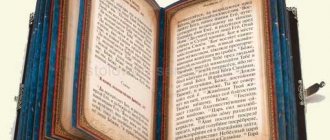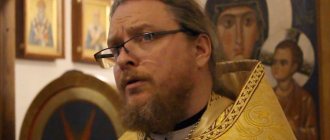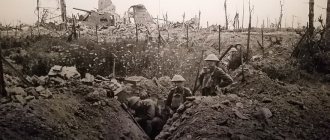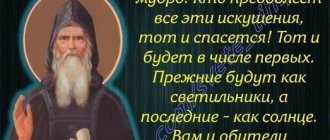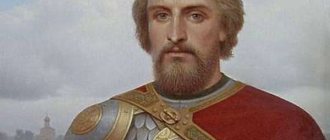Never before has there been a more victorious admiral in the Russian fleet, who managed to preserve all warships, win all 43 battles, secure Crimea for Russia, defeat the Turks, expel the French from the Mediterranean, revolutionize naval warfare and revive a strong and combat-ready force in our country. fleet.
Fyodor Fedorovich Ushakov's naval skill and personal human qualities significantly distinguish him from other famous Russian admirals. After the death of the founder of the Russian fleet, the great reformer Peter I, his life's work experienced difficult times. And when Europe developed maritime art, Russia did not pay attention to the strength and importance of the naval army. This continued until F.F. Ushakov took command of the dying fleet.
Fedor's childhood
The future naval commander Fedor Fedorovich Ushakov was born on February 24, 1745 in the village of Burnakovo, Yaroslavl province, Rybinsk district, when the 16-year-old Russian Empress Catherine II married Peter Fedorovich.
The biography of the great navigator Fyodor Ushakov - an example of perseverance and faith in victory - begins along the sea route not far from the Volga. There, in the center of Russia, in the village of Khopylevo, the dilapidated Church of the Epiphany on Ostrov still stands, where the boy Fedya was baptized. At this male Ostrovsky Epiphany Monastery there was once a school for noble children, in which he learned to read, count and write.
Family
His father was a poor small nobleman Fyodor Ignatievich Ushakov (1710-1781), who served as a sergeant in the Life Guards Regiment of the Preobrazhensky Regiment (retired). Mother Praskovya Nikitichna (1713-1770) - née Ushakova, who was her husband’s fifth cousin, was involved in housekeeping. The family lineage is very ancient and impoverished, originating from the depths of centuries.
From birth, the boy was surrounded by an atmosphere of mercy, mutual respect and love. His parents were very pious and considered the main condition for raising children to be the development of high feelings of religiosity and strict morality. The future sailor was raised by his uncle, Theodore from Sanaksar, an experienced sailor-gunner who graduated from the Naval Cadet Corps in 1766 and served as a midshipman in the Baltic Fleet. Moreover, he was also known as an ascetic monk of the 18th century.
The example of his uncle left a deep imprint on the heart of the growing Fyodor, so even as a child Fyodor began to dream of the sea and fell in love with sails and water. Land fun seemed boring to him, and there was no activity more interesting for him than making boats himself. All the courtyard people admired the work of Fyodor Fedorovich. One day the hunter Prokhor invited the young master to go bear hunting together. The boy was not afraid, but answered: “I will go after a bear only if I meet him on the water.”
Important period
The first and very important period of A.I.’s activity. Ushakov covers 14 years of his life - from 1704 to 1718. During this period, Andrei Ivanovich made a dizzying career from an ordinary guards regiment to a brigadier and a guard major, a man whom the tsar himself valued and respected. His path was not strewn with roses, behind every new military rank, behind every favor of the monarch there were sleepless nights, thousands of kilometers of roads spent in the saddle, blood shed on the battlefields of the Northern War. It was under these conditions that Andrei Ivanovich’s qualities such as diligence, courage, energy, perseverance in achieving his goal, and excellent organizational skills manifested themselves. These same qualities helped Ushakov more than once while commanding a sabotage detachment of Cossacks operating on the communications of the Swedish army, during battles in Poland against supporters of Stanislav Leshchinsky and the Swedish corps of Krassov, during preparations for the defense of Ukrainian lands from the invasion of the Crimean Tatars.
However, circumstances so developed that Ushakov’s main talents were revealed not on the battlefield or in the fight against external enemies, but in protecting the state from such dangers as bribery, embezzlement and malfeasance.
Teenage years and early life
Getting an education
At the age of 16, the village youth was brought to St. Petersburg and assigned to the Naval Cadet Corps. Noble nobles at that time were reluctant to join the fleet. The young man persistently studied science, especially loved arithmetic, navigation and history, and read a lot. Subsequently, this knowledge helped him to successfully conduct not only battles, but also to be a first-class diplomat. Having completed the 5-year corps training with honors with the rank of midshipman in 1766, his first baptism of fire took place on the Don.
Participation in the Russian-Turkish War
The voyage of the future invincible admiral began from the Baltic Sea, and later, in December 1768, as one of the best naval officers, he was transferred to the Don (Azov) flotilla at the disposal of the commander, Vice Admiral A. Senyavin.
Ushakov quickly achieved military success: in 1769 he became a lieutenant, and the following year he became the commander of the Courier, a flat-bottomed artillery sailboat. At the beginning of the Russian-Turkish War, Catherine II conceived the second exit of our power to Europe through the southern Black Sea.
Here the future naval commander gets his first chance to distinguish himself and uses it. In the spring of 1772, he rescues cargo from sunken ships on the Don and earns gratitude from the vice-president of the Admiralty Board, Ivan Chernyshev.
Ship command
The young officer took an active part in the revival of the Russian fleet. At the end of the summer of 1772, F. Ushakov took command of the first deck boat in the flotilla, the Courier, with the aim of capturing enemy merchant ships in the Black Sea.
Since 1773, he already commanded the 16-gun two-masted ship Morea, which almost immediately went out of action due to a general malfunction, then the same ship Modon, which required repair and transfer to Taganrog from Balaklava. Participates in the successful repulsion of the attack of the Turks who landed in Balaklava, and patrols the southern coast of Crimea, which was ceded to Russia under the Kuchuk-Kainardzhi Treaty.
A knowledgeable commander, who made a serious contribution to the development of sailing fleet tactics, transfers camouflaged military ships to the Black Sea and delivers timber to the St. Petersburg shipyards for the construction of ships. Then he again goes to St. Petersburg and performs various tasks, in one of which he was noticed and, for special merits and skills, was appointed captain of the imperial yacht by the empress. However, approaching the imperial person does not attract the ambitious naval officer, and he seeks a transfer to a battleship. From 1775 he commanded a frigate, and in 1776-1779. is on a long voyage in the Mediterranean Sea with the aim of escorting frigates to the Black Sea, performing other tasks. From 1780 to 1782, he commanded the battleship Victor in the Mediterranean Sea.
Mature age
Out to sea on St. Paul
In August 1785, captain of the first rank Feodor Ushakov sailed to Sevastopol from Kherson on the battleship "St. Paul" with 66 cannons on board. And 2 years later, Türkiye again declares war on Russia. In the first general battle, captain of brigadier rank Feodor Ushakov was entrusted with leading the Russian squadron, having only 2 battleships and 10 frigates against 17 Turkish battleships and 8 frigates.
Battle of Fidonisi
In the midst of the summer of 1788, the opponents, having discovered each other, tried to get closer and take an advantageous position. A few days later, a battle began near the island of Fidonisi. The Turkish fleet began to attack the Russian ships with all its superior force. But the outstanding navigator, “using diligence and skill,” as one of the vanguard detachment, gave the order to “add up the sails and, with a decisive maneuver, make it impossible to board the Russian ships.” In addition, he cut off two advanced Turkish ships from the main forces, which immediately began to flee.
For the first time in open battle, a Russian squadron under the leadership of a talented leader in a small number won a psychological, spiritual victory over an enemy superior in strength. After this brilliant battle, the Turks were mortally afraid of “Ushak Pasha,” and Prince Potemkin took him under his protection and in a letter to the empress asked her to show mercy to Ushakov, marveling at his extraordinary desire for victory.
Battle of Kerch
This is one of the first major victories of the young Black Sea Fleet. The Battle of the Kerch Strait took place in early July 1790 near Cape Tequil. The task of the Russian military leader was to close the Ottoman Empire’s entrance to the Sea of Azov and inflict a powerful blow on the enemy fleet, which would not allow it to land troops in the Crimea. Here he uses strategically justified bold offensive actions.
Extraordinary determination and desire to get closer to the shortest distance in order to use canister artillery and rifle fire to inflict the greatest losses on the landing party on enemy ships and deliver a fire strike on Turkish flagship ships in order to deprive the enemy of leadership and courage allow him, while remaining at the head of the attack, to rebuild his ships to create the maximum density of the squadron's linear forces, increase the efficiency of artillery fire and create a reserve of ships at the flagship's disposal.
As a result of the successful battle, many Turkish ships were seriously damaged, one ship was sunk, the Turks suffered heavy losses and were unable to land troops in the Crimea. The commander-in-chief of the Russian fleet was able to apply the basic principles of military art in a specific combat situation, organize the interaction of naval forces and quickly achieve victory. After 4 days, Ushakov returned to Sevastopol harbor.
Battle of Cape Tendra
The naval strategist understood perfectly well that the conclusion of peace could be accelerated only through the complete destruction of the Turkish fleet. Therefore, a month later, a significant battle took place at Cape Tendra, where a squadron of the Black Sea Fleet under the leadership of Ushakov suddenly stumbled upon the fleet of the Ottoman Empire. Contrary to naval law, he ordered an attack on the move. The enemies fled in panic, Russian ships pursued them. The battle lasted the entire next day, and the Russians won a victory, which brought the admiral a high military award and estates in the Mogilev province.
Battle of Cape Kaliakria
The battle of July 31, 1791 in northern Bulgaria, the place where the entire enemy fleet was concentrated, immortalized the name of the great tactician and strategist. Using a huge numerical advantage (78 ships assembled throughout the empire), the Turkish commander Algeria Skabey decided to take Ushakov prisoner.
Lined up along the Black Sea coast under the protection of a battery, Turkish ships were waiting for Russian sailors near the shore. But the experienced commander always carried out detailed reconnaissance before the battle and, having learned the enemy’s intentions, undertook an unprecedented maneuver: to lead his ships along the coast between the battery and the Turkish flotilla, go around behind and, calculating the tailwind, strike point-blank from the leading ship “Rozhdestvo Khristovo”, quickly attack, destroying the entire enemy fleet one by one.
The battle at Cape Kaliakria is the most brilliant victory, the triumph of F.F. Ushakov in the war with Turkey. Turkey was forced to conclude an agreement on peaceful surrender, as a result of which the Russians took possession of the entire northern Black Sea region. Russia received the lands between the Bug and the Dniester.
Construction of the Sevastopol port
The beginning of the basing point on the Black Sea dates back to 1785, when the commander of the battleship “St. Pavel" first arrived in Sevastopol and, with the help of his crew, built a pier and barracks on the eastern shore of the South Bay, which later became known as "Pavlovsky".
After the war, F. F. Ushakov, sparing no time or health, gave birth to the development of the Russian fleet.
In Sevastopol, Rear Admiral:
- builds dozens of new houses;
- builds roads;
- on the high banks opposite each ship he builds stone barracks;
- moves the old barracks from the lowlands to higher ground, where the air is cleaner, significantly reducing the number of sick and dead;
- builds a hospital building, a metalwork and foundry workshop, roads, wells, warehouses where ship property was stored, customs, and areas for placing artillery;
- organizes transportation across bays;
- rebuilds the cathedral church of St. Nicholas;
- provides the city with food, and officers and sailor crews with plots of land in the vicinity of the city in order to improve their nutrition on the spot;
- in “Ushakovaya Balka” on Korabelnaya side he is setting up a garden for country celebrations.
In the 1790s, Sevastopol began to receive foreign merchant ships.
Coalition wars
In November 1792, Ushakov was summoned by Catherine II to St. Petersburg, and on September 2, 1793, while again in Sevastopol, he was awarded the honorary title of vice admiral. From 1794 to 1798, the Black Sea squadrons under his command annually went to sea to protect the coasts from attacks by the French when they appeared in the Black Sea.
In 1798-1800, by decree of Emperor Paul I, Vice Admiral F. F. Ushakov was appointed commander of a squadron of the Russian fleet in the Mediterranean Sea with the aim of capturing the Ionian Islands, blockading French troops in Egypt, disrupting communications and assisting English ships in taking the island. Malta.
During the two-year campaign, the vice admiral proved himself to be a major fleet commander, a skilled politician and statesman in the creation of the Greek Republic of the Seven Islands. He showed an example of interaction between the army and navy during the capture of the Ionian Islands and especially the island of Corfu (Kerkyra), during the liberation of Italy from the French, during the blockade of Ancona and Genoa, and the victory over Rome and Naples. In 1799, Fyodor Fedorovich received the rank of admiral, and the Turkish Sultan presented him with a diamond award and a sable fur coat.
Hike to the Mediterranean Sea
After Russia, together with its former enemy - Turkey - joined the anti-French coalition in August 1798, Admiral Ushakov was given the order to lead the Mediterranean expedition - to lead the Black Sea flotilla to the Ionian Islands and strengthen power there. The campaign was undertaken at the request of the Ottoman Empire for help in the fight against France.
Ushakov's squadron, consisting of 6 battleships, 7 frigates with more than 9 thousand people, with the Turkish military fleet coming under his command, set out to capture the Ionian Islands - the main position of the French. In the shortest possible time, Ushakov's fleet captured the islands (Cherigo, Zante, Kefalonia, San Mavro), the last to surrender was the large, well-fortified island of Corfu with two powerful fortresses. On February 18, 1799, naval artillery delivered a crushing blow, and a 2,000-strong Allied landing force drove the French out of their defensive fortifications. The Eastern Mediterranean became Russian.
From spring to autumn 1799, Ushakov's fleet conducted offensive operations near the coast of Italy (in Rome and Naples), including with the assistance of the British allies. Russian paratroopers took the Italian coast by storm, and in response to a request from Field Marshal Suvorov, who was fighting in Northern Italy, Ushakov gave the order to the Russians to enter port cities off the Adriatic coast, blockade them and cut off the possibility of supplying food and ammunition to the French army by sea. By order of Emperor Paul in 1800, the Russian squadron returned to Sevastopol.
Personal life
In those years, sailing took a long time, and Ushakov did not have time to start a family. He was used to being in the company of sailors and officers and became shy in the presence of ladies. It is known that there was an adopted niece of Pavel Ivanovna, who replaced Fyodor Fedorovich’s daughter.
last years of life
Having gone through all the stages of naval service, without a noble family or patronage, Ushakov spent a lot of effort to receive a charter of nobility and approve the coat of arms of his family, because he had 3 brothers: Gavril, Stepan and Ivan. He bequeathed all his property to his nephews.
According to the main version, in 1807 the admiral retired, refusing the lands and awards promised to him, and settled in the village of Alekseevka, Tambov province, which he had acquired. He was buried in the Sanaksar Monastery on October 2 (14), 1817.
According to another version, he lived for another 23 years, burying his namesake relative, also a sailor, in his place, went with his adopted niece to her estate near Kursk and was buried in Svoboda (Root Desert) in 1841.
Excerpt characterizing Ushakov, Andrey Ivanovich
- See, the stars, passion, are burning! “Tell me, the women have laid out the canvases,” said the soldier, admiring the Milky Way. - This, guys, is for a good year. “We’ll still need some wood.” “You’ll warm your back, but your belly is frozen.” What a miracle. - Oh my God! - Why are you pushing, is the fire about you alone, or what? See... it fell apart. From behind the established silence, the snoring of some who had fallen asleep was heard; the rest turned and warmed themselves, occasionally talking to each other. A friendly, cheerful laugh was heard from the distant fire, about a hundred paces away. “Look, they’re roaring in the fifth company,” said one soldier. – And what a passion for the people! One soldier got up and went to the fifth company. “It’s laughter,” he said, returning. - Two guards have arrived. One is completely frozen, and the other is so courageous, dammit! Songs are playing. - Oh oh? go have a look... - Several soldiers headed towards the fifth company. The fifth company stood near the forest itself. A huge fire burned brightly in the middle of the snow, illuminating the tree branches weighed down with frost. In the middle of the night, soldiers of the fifth company heard footsteps in the snow and the crunching of branches in the forest. “Guys, it’s a witch,” said one soldier. Everyone raised their heads, listened, and out of the forest, into the bright light of the fire, two strangely dressed human figures stepped out, holding each other. These were two Frenchmen hiding in the forest. Hoarsely saying something in a language incomprehensible to the soldiers, they approached the fire. One was taller, wearing an officer's hat, and seemed completely weakened. Approaching the fire, he wanted to sit down, but fell to the ground. The other, small, stocky soldier with a scarf tied around his cheeks, was stronger. He raised his comrade and, pointing to his mouth, said something. The soldiers surrounded the French, laid out an overcoat for the sick man, and brought porridge and vodka to both of them. The weakened French officer was Rambal; tied with a scarf was his orderly Morel. When Morel drank vodka and finished a pot of porridge, he suddenly became painfully cheerful and began to continuously say something to the soldiers who did not understand him. Rambal refused to eat and silently lay on his elbow by the fire, looking at the Russian soldiers with meaningless red eyes. Occasionally he would let out a long groan and then fall silent again. Morel, pointing to his shoulders, convinced the soldiers that it was an officer and that he needed to be warmed up. The Russian officer, who approached the fire, sent to ask the colonel if he would take the French officer to warm him up; and when they returned and said that the colonel had ordered an officer to be brought, Rambal was told to go. He stood up and wanted to walk, but he staggered and would have fallen if the soldier standing next to him had not supported him. - What? You will not? – one soldier said with a mocking wink, turning to Rambal. - Eh, fool! Why are you lying awkwardly! It’s a man, really, a man,” reproaches to the joking soldier were heard from different sides. They surrounded Rambal, lifted him into his arms, grabbed him, and carried him to the hut. Rambal hugged the necks of the soldiers and, when they carried him, spoke plaintively: “Oh, nies braves, oh, mes bons, mes bons amis!” Voila des hommes! oh, mes braves, mes bons amis! [Oh well done! O my good, good friends! Here are the people! O my good friends!] - and, like a child, he leaned his head on the shoulder of one soldier. Meanwhile, Morel sat in the best place, surrounded by soldiers. Morel, a small, stocky Frenchman, with bloodshot, watery eyes, tied with a woman's scarf over his cap, was dressed in a woman's fur coat. He, apparently drunk, put his arm around the soldier sitting next to him and sang a French song in a hoarse, intermittent voice. The soldiers held their sides, looking at him. - Come on, come on, teach me how? I'll take over quickly. How?.. - said the joker songwriter, who was hugged by Morel. Vive Henri Quatre, Vive ce roi vaillanti – [Long live Henry the Fourth! Long live this brave king! etc. (French song)] sang Morel, winking his eye. Se diable a quatre... - Vivarika! Vif seruvaru! sit-down... - the soldier repeated, waving his hand and really catching the tune. - Look, clever! Go go go go!.. - rough, joyful laughter rose from different sides. Morel, wincing, laughed too. - Well, go ahead, go ahead! Qui eut le triple talent, De boire, de battre, Et d'etre un vert galant... [Having triple talent, drinking, fighting and being an amiable...] - But it’s also neat. Well, well, Zaletaev!.. “Kyu...” Zaletaev said with effort. “Kyu yu yu...” he drawled, carefully protruding his lips, “letriptala, de bu de ba and detravagala,” he sang. - Hey, it’s important! That's it, guardian! oh... go go go! - Well, do you want to eat more? - Give him some porridge; After all, it won’t be long before he gets enough of hunger. Again they gave him porridge; and Morel, chuckling, began to work on the third pot. Joyful smiles were on all the faces of the young soldiers looking at Morel. The old soldiers, who considered it indecent to engage in such trifles, lay on the other side of the fire, but occasionally, raising themselves on their elbows, they looked at Morel with a smile. “People too,” said one of them, dodging into his overcoat. - And wormwood grows on its root. - Ooh! Lord, Lord! How stellar, passion! Towards the frost... - And everything fell silent. The stars, as if knowing that now no one would see them, played out in the black sky. Now flaring up, now extinguishing, now shuddering, they busily whispered among themselves about something joyful, but mysterious. X The French troops gradually melted away in a mathematically correct progression. And that crossing of the Berezina, about which so much has been written, was only one of the intermediate stages in the destruction of the French army, and not at all a decisive episode of the campaign. If so much has been and is being written about the Berezina, then on the part of the French this happened only because on the broken Berezina Bridge, the disasters that the French army had previously suffered evenly here suddenly grouped together at one moment and into one tragic spectacle that remained in everyone’s memory. On the Russian side, they talked and wrote so much about the Berezina only because, far from the theater of war, in St. Petersburg, a plan was drawn up (by Pfuel) to capture Napoleon in a strategic trap on the Berezina River. Everyone was convinced that everything would actually happen exactly as planned, and therefore insisted that it was the Berezina crossing that destroyed the French. In essence, the results of the Berezinsky crossing were much less disastrous for the French in terms of the loss of guns and prisoners than Krasnoye, as the numbers show. The only significance of the Berezina crossing is that this crossing obviously and undoubtedly proved the falsity of all plans for cutting off and the justice of the only possible course of action demanded by both Kutuzov and all the troops (mass) - only following the enemy. The crowd of Frenchmen fled with an ever-increasing force of speed, with all their energy directed towards achieving their goal. She ran like a wounded animal, and she could not get in the way. This was proven not so much by the construction of the crossing as by the traffic on the bridges. When the bridges were broken, unarmed soldiers, Moscow residents, women and children who were in the French convoy - all, under the influence of the force of inertia, did not give up, but ran forward into the boats, into the frozen water. This aspiration was reasonable. The situation of both those fleeing and those pursuing was equally bad. Remaining with his own, each in distress hoped for the help of a comrade, for a certain place he occupied among his own. Having given himself over to the Russians, he was in the same position of distress, but he was on a lower level in terms of satisfying the needs of life. The French did not need to have correct information that half of the prisoners, with whom they did not know what to do, despite all the Russians’ desire to save them, died from cold and hunger; they felt that it could not be otherwise. The most compassionate Russian commanders and hunters of the French, the French in Russian service could not do anything for the prisoners. The French were destroyed by the disaster in which the Russian army was located. It was impossible to take away bread and clothing from hungry, necessary soldiers in order to give it to the French who were not harmful, not hated, not guilty, but simply unnecessary. Some did; but this was only an exception. Behind was certain death; there was hope ahead. The ships were burned; there was no other salvation but a collective flight, and all the forces of the French were directed towards this collective flight. The further the French fled, the more pitiful their remnants were, especially after the Berezina, on which, as a result of the St. Petersburg plan, special hopes were pinned, the more the passions of the Russian commanders flared up, blaming each other and especially Kutuzov. Believing that the failure of the Berezinsky Petersburg plan would be attributed to him, dissatisfaction with him, contempt for him and ridicule of him were expressed more and more strongly. Teasing and contempt, of course, were expressed in a respectful form, in a form in which Kutuzov could not even ask what and for what he was accused. They didn't talk to him seriously; reporting to him and asking his permission, they pretended to perform a sad ritual, and behind his back they winked and tried to deceive him at every step.
Canonization of Fedor
The activities of F. F. Ushakov left a deep mark on the history of Russia. Admiral Fedor Fedorovich Ushakov devoted his entire life to serving the Fatherland. He led a righteous life, and while commanding tens of thousands of sailors and officers and caring for them like a father, he saved his personnel (less than 500 people were killed). The admiral was truly responsible for each subordinate before God and his conscience, realizing the equality of the people entrusted to him in moments of terrible danger.
In 2001, the Russian Orthodox Church canonized the holy righteous warrior Theodore Ushakov. Believers consider him the patron saint of military sailors.
Personal life
When Fyodor Ushakov served in the Azov flotilla, he fell in love for the first time and forever. He did not have time to marry his bride before being sent to the Black Sea. When he returned, the woman found herself married to a rich Greek merchant. It is known that the son of his beloved later served under the command of the Admiral.
Having devoted his entire life to serving the Fatherland, the unique strategist and tactician did not have time to start a family . After retirement, he was engaged in prayers and charity. Two orphaned nephews and a niece lived with him.
Saint Admiral's Awards
F. F. Ushakov was awarded the following orders:
- St. George 2nd class (1790) and 4th class (1788);
- St. Vladimir 2nd (1790), 3rd (1788) and 4th (1785) degrees;
- St. Alexander Nevsky (1791);
- Saint Januarius (Kingdom of Naples, 1799).
It is marked:
- Commander's Cross of St. John of Jerusalem (1798);
- chalk (Ottoman Empire, 1799);
- diamond signs to the Order of St. Alexander Nevsky (1798);
- golden weapons (Republic of the Seven Islands).
Personality characteristics according to the memoirs of contemporaries
Many people who communicated with F. Ushakov noted his extraordinary simplicity in communication, goodwill and directness, combined with courage, courage, enormous willpower and endless faith in God. According to eyewitnesses, in any battle Ushakov ordered to lead his ship to the epicenter of the battle, showed the sailors and officers a personal example of courage and courage, and himself gave combat commands.
Defeated enemies always asked Ushakov for mercy, sent envoys, offered rich ransoms, and Fyodor Fedorovich spared the enemies. They talked about him as a very pious and kind person, at the same time hot-tempered, persistent and strict with the officers, but fair, loved and deeply respected by Russian sailors and Turks. Ushakov's eminent contemporaries Suvorov and Nelson emphasized his independence in actions and decisions and unprecedented courage.
Researchers' assessments
Bantysh-Kamensky wrote about Ushakov: “Running the secret office, he carried out the most severe tortures, but in society he was distinguished by a charming manner and had a special gift for finding out the way of thinking of his interlocutors.” And here is the opinion of E. Anisimov[3]:
General Ushakov led the secret chancellery under five monarchs. And he knew how to negotiate with everyone! First he tortured Volynsky, and then Biron. Why? Because there is some kind of connection between the head of state and the head of the investigation. They know dirty secrets. That’s why they always find a common language. Ushakov was a professional; he didn’t care who he tortured.
Honor and memory of Admiral Ushakov
Memorial Day of F. F. Ushakov - October 15.
Named after him:
- a bay in the southeastern part of the Barents Sea and a cape on the northern coast of the Sea of Okhotsk;
- local history museum and street in Temnikov;
- boulevard and Moscow metro station;
- Maritime State Academy in Novorossiysk;
- embankment, bridge and monument in St. Petersburg;
- square in Sevastopol;
- streets in Minsk, Aleksandrov and Chelyabinsk;
- boulevard in Rybinsk;
- street and monument in Sarov (Arzamas-16);
- main avenue and state maritime institute in Kherson;
- asteroid 3010 Ushakov;
- flotilla of young sailors in Yaroslavl;
- Naval Institute in Kaliningrad;
- font at the holy spring near the Church of the Assumption of the Virgin Mary in the village of Molochkovo, Soletsky district, Novgorod region;
- stele near the village of Khopylevo;
- On March 3, 1944, the Presidium of the Supreme Soviet of the USSR established a military order of two degrees and the Ushakov medal;
- a bust was erected in Rybinsk, Yeisk in the Krasnodar Territory, Rostov-on-Don, Tutaev in the Yaroslavl Region, Messina in Italy and on the island of Zakynthos in Greece;
- monuments in the family estate Alekseevka, on the island of Corfu and on Cape Kaliakra.
Temples in honor of the saint
The following temples were named in the name of Saint Theodore Ushakov:
- Cathedral of the Holy Righteous Warrior Theodore Ushakov in Saransk;
- temple in South Butovo in Moscow and Sevastopol;
- Cathedral in Mordovia;
- temple-chapel of the Holy Righteous Warrior in Anapa and in the Krasnoarmeysky district of Volgograd on the banks of the Volga-Don Canal;
- chapel in the Kronstadt Naval Cadet Corps; in Kherson and Sevastopol.
Ships named after Feodor
The proud name of the great naval commander is:
- The coast guard battleship "Admiral Ushakov" (the name was chosen by Emperor Alexander III) was built at the Baltic Shipyard, launched on October 27, 1893, and became part of the Baltic Fleet.
- The light cruiser of Project 68 bis “Admiral Ushakov” (1981) is the first Soviet ship with that name, launched in 1952.
- Heavy nuclear missile cruiser Project 1144 "Orlan".
- "Kirov" received the name of the admiral in 1992.
- The destroyer of the project "Besstrashny", renamed "Admiral Ushakov" in 2004, was launched on December 28, 1991. Until 1994, the ship belonged to the Baltic Fleet, later - to the Northern.
- Self-elevating modular platform designed for engineering work in coastal waters at a depth of up to 24 m and laying pipelines.
Other
The hero of the Russian-Turkish War looks at his descendants from his famous portrait. But is this what Fedor Ushakov looked like? This question remains open.
The work of the artist Pyotr Bazhanov was completed in 1912 - almost 100 years after the death of F. F. Ushakov. No other images have survived to this day. For many years this question did not bother anyone. Only in 1943, when Stalin decided to establish the Order of Ushakov, the scientific community considered that the artist used another lifetime image as a model and copied the image from the portrait on the medal.
In August 1944, a special commission set out on a secret mission to find the grave and relics of the admiral in the Sanaksar Monastery. It turned out to be plundered. The researcher of the remains, the famous anthropologist M. Gerasimov, sculpted the face using the method of plastic reconstruction and came to the conclusion that the portrait did not look like Bazhanov’s painting. It is likely that this is a relative and namesake of the admiral, who served on his ship, and Fyodor Fedorovich himself spent the last years of his life near Kursk in the Root Hermitage, where he was transported by his adopted niece Pavla immediately after the burial of a relative in order to protect his relatives from the persecution of Soviet power.
A resident of Kursk, Svetlana Vyrenkova, talks in detail in the newspaper “Friend for a Friend” (No. 50 of December 11, 2018) about how Pavel Ivanovna Ushakova-Brezhneva brought the seriously ill admiral to her estate near Kursk, where he lived for another 23 years and was buried in Brezhnev family tomb near the old wooden temple of Joachim and Anna in the village of Dolgoe.
Are the ships storming the bastions?
During the fighting against Corfu, contrary to popular belief, which arose primarily thanks to the feature film “Ships Storm the Bastions,” Admiral Ushakov’s squadron did not actually storm the bastions. The ships fired not at the Corfu fortress, but at the few and practically unprotected batteries of the island of Vido. The shelling of the Old Fortress from the sea was symbolic and had only a moral effect. It would be simply madness for Ushakov to expose ships to the numerous coastal artillery of the most powerful citadel.
The main reason for the premature surrender of Corfu by the French was their obvious reluctance to fight. And this is understandable: after the Battle of Abukir, the island of Corfu as a strategic base of the French fleet lost its importance, and the garrison of the fortress understood perfectly well that no one would come to its aid. The French generals believed that they and their troops at that moment were more needed in France than on a distant island, and if the conditions of surrender were acceptable, they were ready to immediately surrender. And the terms of surrender they were offered were, one might say, honorable. The act of surrender stated that “the French garrison ... with military honors will leave all the fortresses and gates that it now occupies, and, having been brought into line, will lay down their weapons and banners, excluding the generals and all officers and other officials who remain with your weapon. After this, this garrison with its own crew will be transported to Toulon on hired ships... under the cover of military ships... the generals and the entire French garrison undertake on their word of honor not to take weapons against the All-Russian Empire and the Ottoman Ports and their allies for 18 months.”
A still from the feature film “Ships Storm the Bastions” (1953, director Mikhail Romm).
The image of the admiral in culture and art
His image attracted many representatives of the creative intelligentsia:
- artists I. Pavlinov, A. Blinov and V. Ilyukhin;
- Midshipman A. Decalde;
- sculptors N. Dadynin, P. Kravchenko and A. Chubin;
- writer A. Stein;
- director M. Romm;
- icon painter S. Mishchenko.
Literature
- Kolpakidi A., Sever A.
Special services of the Russian Empire. - M.: Yauza Eksmo, 2010. - P. 450. - 450 p. — (Encyclopedia of Special Services). — 3000 copies. — ISBN 978-5-699-43615-6.
- Oleg Ryaskov.
"Notes of the forwarder of the secret chancellery." - M.: Yauza Eksmo, 2010. - P. 350. - 350 p. - (Adventures). — 5000 copies. — ISBN 978-5-699-46517-0. - Oleg Ryaskov.
“Notes of the forwarder of the secret chancellery. To the shores of New England." - M.: AST, 2011. - P. 350. - 768 p. - (Adventures). — 4000 copies. — ISBN 978-5-170-74708-5.
- Burukin V.V. Andrey Ivanovich Ushakov: Personality and state activity: Abstract...candidate of historical sciences. – Voronezh, 2005.
Interesting facts about life
Ushakov's squadron was rapidly approaching the enemy and, without changing formations customary at that time, attacked the flagship, maneuvered freely, shooting the enemy from a short distance. Recognizing only victories, the naval commander pursued and destroyed all those who did not surrender.
He served in the navy for 44 years, participated in 3 wars, and did not know a single defeat.
He did a lot of charitable work, often donated his money to orphanages, and built hospitals with his own money.
The life of the great son of Russia was similar to monasticism.
Number of victories won.
In literature and the Internet you can often find the phrase: “out of 43 naval battles, Ushakov did not lose a single one.” How realistic is this figure?
Undoubtedly, Admiral Ushakov played an important role in the formation of the Russian fleet; it is not for nothing that he is compared to Suvorov. He acted boldly and decisively, under his command the fleet achieved brilliant victories at Tendra, at Kaliakria, at the island of Corfu... But even if you count minor skirmishes and actions against the Greek islands, the number of battles under the command of Ushakov is still significantly less than 43. And where this figure even came from is unclear.
Battle of Tendra Island on August 28-29, 1790. Artist A.A. Blinkov.
